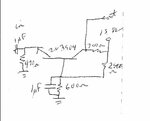obrien135
Full Member level 5
- Joined
- Nov 10, 2009
- Messages
- 240
- Helped
- 5
- Reputation
- 10
- Reaction score
- 5
- Trophy points
- 1,298
- Location
- Connecticut
- Activity points
- 3,259
Hello again, annd thanks for all the help I have gotten so far. I have another question. The LM386 datasheet seems to indicate that it should be bypassed by a 10uF capacitor between pin 7 and ground. I don't have one, can I use a 4.7uF, or do Ihave to get a 10uF? The data sheet doesn't make it clear if it has to be a 10uF. It's a little vague about it.
George
George


